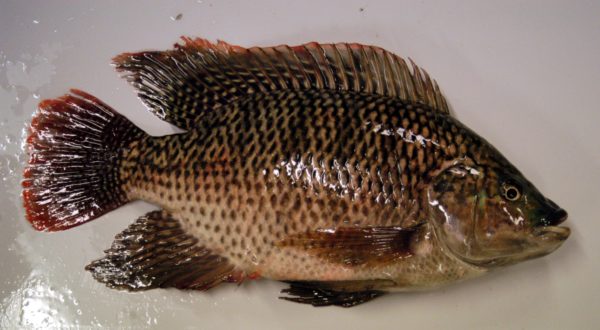
10 ways to terminate tilapia!
Posted on May 23rd, 2018
-
Learn how to confidently identify the species
Tilapia are an invasive pest fish, with adults distinctly recognized by a continual dorsal fin.
Most native Australian fish have a dip or dent in their dorsal fin.
Juvenile tilapia are identified by a small black spot at the end of their dorsal fin.

-
Dispose responsibly
Upon catching a tilapia, there is only 1 legal action to take.
To humanely kill with a sharp blow to the back of the head and dispose of responsibly.
Burying the carcass at least 50m away from tidal influences eliminates any possibility of survival.
The distance is imperative, as female tilapia are mouth brooders, meaning they protect their eggs and young by carrying them in the mouth.
Burying 50m away from tidal influences ensures that if there are eggs or young in a female’s mouth, they are unable to survive.
-
Report any sightings
If you catch a tilapia, reporting the sighting is crucial!
Waterway management depends on the eyes of the community to achieve a vast and encompassing perspective.
Report all sightings to Feral Fish Scan at www.feralscan.org.au/feralfishscan/
Taking a photograph of the fish is the best way to relay detailed, reliable information.
FBA receives notifications of feral fish sightings within the Fitzroy Basin.

-
Don’t flush aquarium fish down the toilet

Contrary to popular belief, it is highly destructive to flush aquarium fish, dead or alive, in the toilet.
It is believed that doing so has lead to infestations of ornamental fish in Australian waterways.
There are many reasons we wish to discourage this behaviour.
- The fish may not actually be dead – think of Nemo escaping the dentist in Finding Nemo!
- Mouth brooders protect their young in their mouth – even if the adult dies, their young can survive
- You can easily spread disease – if the fish is dead, there’s a chance it could be infected!
- Exotic plants and their seeds can be spread
It takes very little for an introduced fish species to dominate a waterway where there are no predators, and abundance of food and the potential to breed.
-
NEVER release aquarium fish into waterways.
It’s hard to believe that people think releasing live aquarium fish into a river, creek or stream is a good idea, but it does happen.
Introducing foreign fish into waterways is the primary ingredient for disaster!Prolific breeders, presented with a habitat where there is no predators and an abundance of food is all it takes for an animal to become a pest.
It is also critical to keep screens atop backyard ponds to avoid spread during times of flooding and heavy rainfall.
-
Seek advice if you’re unsure.
Identification can be a bit tricky, and until you’re familiar with the distinguishing features of tilapia, seeking advice is the best option.
The Queensland Government is available to answer calls relating to sightings on 13 25 23.
There are also several handy websites available as resources.
Department of Agriculture and Fisheries
Department of Environment and Science
PestSmart
-
Never relocate fish across waterways, especially not livebait.
The seemingly harmless act of catching bait in one water system and fishing with that bait in another can absolutely lead to an ecological disaster.
It only takes one person to do it once, and the effects are felt forever!
You may be catching juvenile tilapia without even realising.
8. Know where infestation is occurring, and whether to expect tilapia.
There are areas within the Fitzroy Basin that are infested with tilapia.
The Fitzroy River, Isaac and Mackenzie Rivers, Raglan Creek and Yeppen lagoon are all confirmed tilapia habitats.
At these sites, you must be aware of the correct disposal methods.
At other waterways such as the Boyne and Calliope Rivers, the Don and Dee Rivers and Waterpark Creek – the public need to remain on high alert for tilapia.

Download a high resolution copy of this map here:
-
Be on high alert for tilapia following flooding
Following flooding events, tilapia have the potential to be mobilized across weirs and waterways.
Every instance of a peak water event instigates a fresh alert for tilapia.
Areas of particular concern following these significant weather patterns include:
- Calliope River & Boyne River in the Gladstone region;
- The Mackenzie River between Blackwater and Middlemount;
- all waterways in the Duaringa to Mt Morgan area including Dululu and Wowan;
- Yeppoon and Waterpark Creek and
- the Connor’s River north of St Lawrence.
[embedyt] https://www.youtube.com/watch?v=xXLOWEDLfo0[/embedyt]
-
Love your creek!
Through promoting healthy habitats for native species of fish, we increase their chances of maturing into adults.
Keeping litter out of waterways, washing cars on the grass and composting green waste are all small backyard actions we can take to support native fish species thriving in our waterways.








